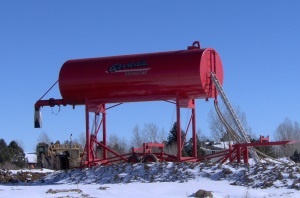Treating infected fuel - where do the fuel bugs go?
When we were at the PowerGen Show (the yearly trade show for the power generation industry) in Orlando last week, we saw lots of generator dealers...

 Everyone who stores fuel for use knows (or should know) that controlling the inevitable water accumulation in the fuel storage tank is the single more important "housekeeping" step they can take to prevent bigger problems down the road. And by bigger problems, we mean microbial contamination of the fuel tank that likely would result in thousands of extra dollars in expense for the fuel/equipment problems they cause and the cost of getting rid of them.
Everyone who stores fuel for use knows (or should know) that controlling the inevitable water accumulation in the fuel storage tank is the single more important "housekeeping" step they can take to prevent bigger problems down the road. And by bigger problems, we mean microbial contamination of the fuel tank that likely would result in thousands of extra dollars in expense for the fuel/equipment problems they cause and the cost of getting rid of them.
We call water accumulation inevitable because it pretty much happens with most fuel tanks that are vented to the outside in any way, with water condensing out of the inside air due to simple changes in temperature even from daytime to nighttime.
Here are the basic recommendations to stay on top of potential water problems in fuel storage tanks:
1. Check for water every 30 days
People ask how often they should check for water. Every 30 days is the general rule of thumb used by many. Yet a lot of place don't follow this rule at all. Checking for water is relatively simple; the only things you really need are a tank-dipping stick (preferably with measuring gradations) and some water-finding paste.
2. Decide on a limit to the water depth before action is taken
The depth of the water will correspond to a given number of gallons of water that will be residing in that storage tank at any certain time. How many gallons depends on the size and shape of the tank. The most common recommendations are a maximum depth of 1/4 to 1/2 of an inch for some fuels and 2 inches for diesel. The Kansas Department of Agriculture uses a max of 1/4 inch for aviation fuel and biodiesel, and 2 inches for diesel fuel. How do you tell what the depth is? Put a length of water-finding paste on the tank stick, stick the tank to its bottom, pull the stick back out of the tank and see how far up the waste paste has changed color.
3. Have a plan of action to remediate the water phase
Some tanks are designed with valves at the bottom that can enable you to simply drain off the water phase. Depending on said tank design, you can get some or most of the water phase out this way without losing any fuel. In order to preserve the maximum volume of fuel left in the tank, you can use a water-absorbing treatment to take out much of the rest of the water left over. The more water you can remove at any given time, the more time you'll have before potential problems read their head in the future.

When we were at the PowerGen Show (the yearly trade show for the power generation industry) in Orlando last week, we saw lots of generator dealers...

You accidentally left your gas cap off in rainy weather. Or the gas station you fueled up at has a bad water filter and delivered you a slug of...

Through the Contact Us forms on the Bell web site, we get all kinds of inquiries about fuel problems and engines from the general public. Some of...